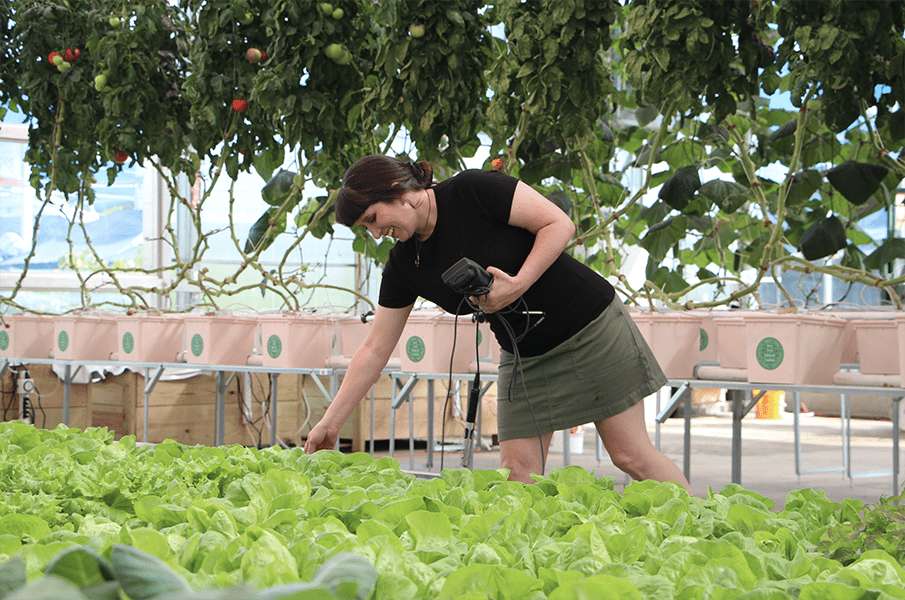
By Karla Garcia, Hort Americas Technical Services
Plant nutrition is a key factor in growth and yield. But how can we know which nutrient is missing? Or which is the best fertilizer for our crop?
In learning about plant nutrition, we first need to know there are nutrients required in greater quantities than others. The nutrients that are essential for plant growth are called “macronutrients”. The rest of the nutrients also essential for plant growth but in lower quantities are called “micronutrients”.
Macro nutrients: Potassium (K),Phosphorous (P), Nitrogen (N), Calcium (Ca), Magnesium (Mg) and Sulfur (S).
Micronutrients: Iron (Fe), Manganese (Mn), Zinc (Zn), Copper (Cu), Boron (B), Molybdenum (Mo), Chloride (Cl).
Plants take nutrients by 2 ways: passive and active. It is very important to differentiate between passive and active nutrients, so you can correctly fix nutrient deficiencies.
Most fertilizers will show a proportion of primary macronutrients: N,P and K. Nitrogen is one of the most important nutrients for plant growth. It is important to know, the more nitrogen your fertilizer has, the more that vegetative growth will be promoted. This is good during phases where we want our plants to grow but when starting the reproductive phase you need to re-check your nutrient levels and reduce nitrogen. On the other hand, Potassium is more related to the reproductive phase and fruit production, this nutrient is usually increased during the reproductive phase.

Passive nutrients are chemicals moving in plants by mass flow and ion diffusion. The nutrients moving by mass flow will be directly related to plant transpiration. If plants have a proper transpiration, then there will be no issue with the movement of these nutrients, but if transpiration is affected, then even having the nutrient present in your fertilizer will not help plants be able to move passive nutrients efficiently and nutrient deficiency symptoms can appear. Some passive nutrients are: Calcium (strongly related to mass flow), Magnesium (strongly related to mass flow), Sulfur, Iron, Copper and Boron. On the contrary, active nutrients can always be taken up by the plant when available in our fertilizer.
One factor that can affect uptake of passive and active nutrients is pH. If pH is out of recommended ranges for your crop then nutrient uptake can be affected. Every time you spot a nutrient deficiency, first make sure pH is on the recommended range, then check if the symptoms relate to a passive or an active nutrient. If deficiency corresponds to a passive nutrient first make sure your environmental conditions are ideal for water uptake before adding the missing nutrient. If the nutrient deficiency corresponds to an active nutrient then you can fix the issue by adding the missing nutrient.
In Hort Americas we care about your plant nutrition. For this reason in cooperation with CEA hydroponic specialists, academicians and researchers we have developed an hydroponic nutrient recipe specific for growing the best leafy greens. We know not all crops have the same requirements, that is why we put all our knowledge into develop a formula with a great nutrient balance to promote growth in leafy greens. Hort Americas’ fertilizer has been used successfully for our customers for growing all kind of leafy greens like: lettuces, basil, microgreens and culinary herbs.
How to use Hort Americas hydroponic fertilizer?
You can prepare your own nutrient solution by mixing our soluble fertilizer with your test-proved water. We suggest to utilize from 0.271 to 0.455 lbs of HA fertilizer in 100 gallons of water. Calcium nitrate (3.58 g /gallon) and magnesium sulfate (1.67 g/ gallon) must be added to complete the formula. You can adjust electrical conductivity (EC) by adding or reducing the amount of fertilizer used. The table below shows suggested EC levels for different leafy green crops:
| Crop | Stage 1
Seeding and germination | Stage 2
Nursery/ propagation | Stage 3
Finishing/ maturation |
| Lettuce | Gradually increase the nutrient solution EC to1.0 to 1.2 mS/cm.
pH 5.4 to 5.8 | EC levels of 1.8 to 2.4 mS/cm in winter and 1.4 to 1.6 mS/cm in summer to assist rapid uptake of water and to prevent tip burn.
pH 5.4 to 5.8 | EC levels at 1.8 to 2.4 mS/cm in winter and 1.4 to 1.6 mS/cm in summer to assist rapid uptake of water and to prevent tip burn.
pH 5.4 to 5.8 |
| Basil | EC of 0.3 to 0.5 mS/cm
pH of 5.8 to 6.2. | Increase the nutrient solution gradually to 1.0 mS/cm
pH of 5.8 to 6.2. | EC levels of 1.0 to 1.4 mS/cm withpH of 5.8 to 6.2. |
| Microgreens | With microgreens we suggest to reduce the amount of HA fertilizer utilized as follows:
1.1 oz to 1.82 oz/100 gallons – 1.23 to 2.06 grams per 4 gallons. Add to the nutrient solution 3.58 grams of calcium nitrate per 4 gallons nutrient solution and 1.67 grams magnesium sulfate per 4 gallons. |
In Hort Americas we want you to grow great crops!
Please contact us with any questions. As with many of our customers, we also want to be part of your successful project!






You must be logged in to post a comment.